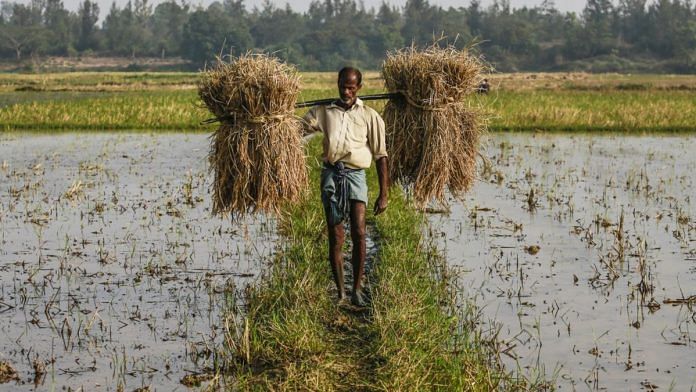New Delhi: Rabi crops across many parts of North India have witnessed heavy damage due to the repeated spells of heavy rain accompanied by hailstorm and strong winds this month.
India registered an over 80 per cent increase in rainfall in the first two weeks of March — from an average of 9.3 mm to 16.9 mm. Major wheat and mustard producing states such as Punjab, Haryana, Uttar Pradesh and Rajasthan bore the maximum damage.
A senior Union agriculture ministry official, who did not want to be named, said at least 20 per cent of wheat crop have been damaged in the districts of Punjab. “In Haryana and Rajasthan, the damage estimates for wheat and mustard as for now stands at around 10-15 per cent,” the official added.
The ministry, however, is yet to give a monetary estimate of the damaged crops.
Punjab, which is often referred to as the food bowl of India, has been the worst hit followed by Haryana, Rajasthan and Uttar Pradesh. The state cultivates wheat in more than 35 lakh hectares out of the state’s total 40 lakh hectares of cultivable land.
The official quoted earlier said unless the central government gets the complete damage report, it can’t decide on the compensation to be given to farmers.
Also read: Climate change doesn’t just cost us the environment, but a pretty penny too
UP received 667% higher rainfall in March
According to the All India Crop Situation as on 13 March 2020, Uttar Pradesh, which is the largest wheat-producing state, recorded 23.8 mm rain in March. This is 667 per cent higher than the normal rainfall level of 3.1 mm during this period. Similarly, Punjab, Madhya Pradesh, Haryana, Rajasthan and Bihar have also recorded much higher rainfall than is normally recorded during this period — 311 per cent, 168 per cent, 702 per cent, 685 per cent and 604 per cent, respectively.
Navdeep Dahiya from Live Weather told ThePrint that rainfall and wind during these months are normal as per the norm of annual western disturbances. “It is however the intensity of these events that are causing crop damage across large scale in Northern and Western parts of the country.”
Dahiya added that the wind speed used to be around 30-40 kmph earlier but it’s around 60-70 kmph this year with the added damage-causing elements like heavy rainfall and intense hailstorm, which flattens the standing crop of mustard and wheat that are almost ready to be harvested now.
Officials from the Punjab agriculture ministry told ThePrint that around 3.8 lakh hectares of the wheat crop has been damaged and flattened across many districts of the state. The worst-hit areas include Fazilka, where rains were observed mainly from 10-12 March and crops in at least 48,000 hectares were flattened.
Other areas that witnessed severe crop damage include Patiala (27,000 hectares), Rupnagar (20,000 hectares), Fatehgarh Sahib (11,100 hectares) and Hoshiarpur (9,000 hectares).
In Haryana, districts like Hisar, Rohtak, Sirsa, Ambala, Yamunanagar, Kurukshetra and Panipat were the worst hit. Haryana Agriculture and Farmers Welfare Minister J.P. Dalal told the media that the mustard has suffered maximum damage as the crop was almost ready to be harvested. “At some places, the damage is up to 50 per cent,” said Dalal, adding the government gives compensation at the rate of Rs 12,000 per acre.
In Rajasthan, about 60 per cent of the standing mustard crop was severely damaged.
In UP, farmers in the region across Agra like Baghpat and Moradabad have suffered loss to potato, wheat and mustard crops.
Also read: The ‘insect plague’ that’s eating crops in India & why monsoon may not bring good news




According to news report in April , 2020 , untimely rains and winds have in April 2020 caused damage to 20-25 percent paddy , wheat , mustard and chickpea crops in several parts of the country besides affecting the harvesting of potato. In this context , it may be apt to refer readers to this Vedic astrology writer’s predictive alert in article – “ Predictions for coming year 2020 by kushal kumar” – published last year 2019 on 10 October at theindiapost.com/articles/predictions-for-coming-year-2020-by-kushal-kumar/. The predictive alert had advised taking of more care and appropriate strategy against damage to crops during April to June 2020 in India. It seems the predictive alert sufficiently prior on 10 October , 2019 was meaningful.